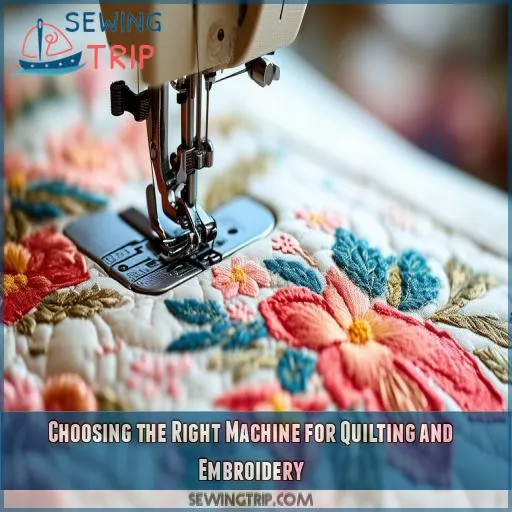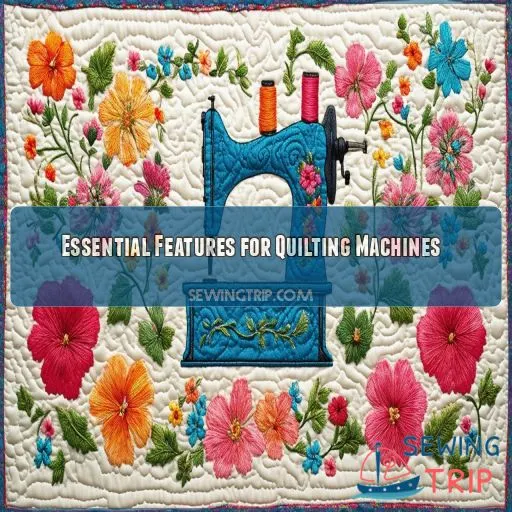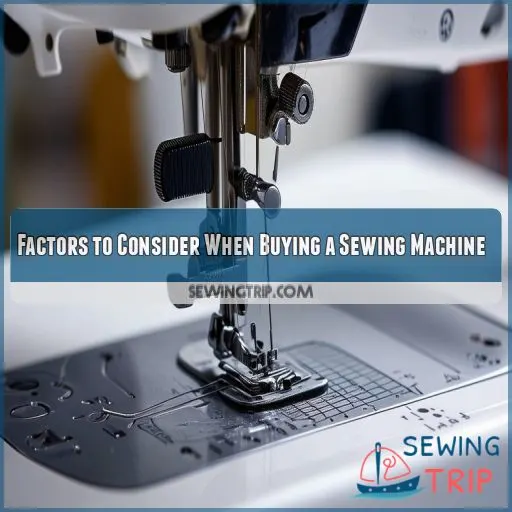This site is supported by our readers. We may earn a commission, at no cost to you, if you purchase through links.
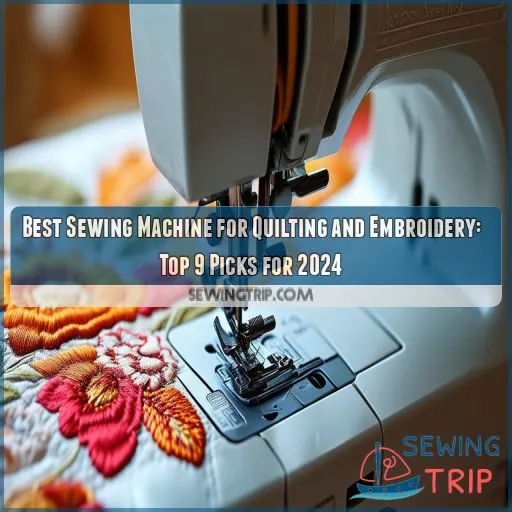
The Brother SE600 and CS7000X are excellent all-rounders, offering both quilting and embroidery features.
Consider your budget, intended use, and desired features like automatic needle threading or LCD displays. Don’t forget to factor in the machine’s size, weight, and brand reputation.
Whether you’re a beginner or seasoned sewist, there’s a perfect machine out there for you. Let’s explore your options to find your ideal quilting and embroidery companion.
Table Of Contents
- Key Takeaways
- 9 Best Sewing Machines for Quilting and Embroidery
- 1. Brother CS7000X Sewing Quilting Machine
- 2. Brother SE600 Sewing Embroidery Machine
- 3. Juki TL2000Qi Sewing Quilting Machine
- 4. Brother HC1850 Sewing and Quilting Machine
- 5. Janome Blue Couture Sewing Machine
- 6. JUKI MO600N Portable Thread Serger
- 7. Janome HD1000 Black Edition Sewing Machine
- 8. Brother Sewing Quilting Machine
- 9. Brother Computerized Sewing Machine
- Choosing the Right Machine for Quilting and Embroidery
- Essential Features for Quilting Machines
- Factors to Consider When Buying a Sewing Machine
- Frequently Asked Questions (FAQs)
- Conclusion
Key Takeaways
- Picking the perfect quilting and embroidery machine is like finding a dance partner – you need one that moves in sync with your creative rhythm. Look for features like wide throat space, dual-feed presser feet, and built-in embroidery designs to waltz through your projects with ease.
- Don’t let your budget burst at the seams! There’s a machine for every wallet thickness, from budget-friendly beginners’ models to high-end powerhouses. Just remember, sometimes you’ve got to spend a pretty penny to make those pretty patterns.
- Brand reputation isn’t just a fancy label – it’s your lifeline when things go south. Opt for brands known for stellar customer support and tutorials. After all, you don’t want to be left hanging by a thread when your machine throws a tantrum mid-project!
- Features, features, features! From knee lifters to stitch regulators, today’s machines are packed with more bells and whistles than a one-man band. But don’t get bamboozled by the bling – focus on the features that’ll truly make your sewing sing.
9 Best Sewing Machines for Quilting and Embroidery
You’ll find an assortment of exceptional sewing machines for quilting and embroidery in our 2024 lineup, including models from Brother, Juki, and Janome. These machines offer features like wide throat space, dual-feed presser feet, and built-in embroidery designs to help you tackle your most ambitious quilting and embroidery projects with ease.
1. Brother CS7000X Sewing Quilting Machine
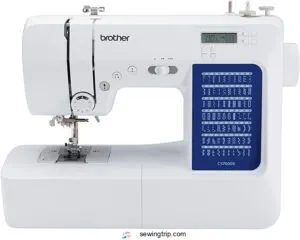
Looking for a versatile machine that’ll handle your quilting projects with ease? The Brother CS7000X might be your perfect match. With 70 built-in stitches and 7 one-step buttonholes, you’ll have plenty of options at your fingertips.
Its improved needle threader and large workspace make setup a breeze, while the metal frame guarantees durability. You’ll love the included wide table for those bigger quilts.
Plus, with a max speed of 750 stitches per minute, you’ll zip through projects in no time. Just remember, it’s designed for US voltage only.
Best For: Quilters and sewers seeking a versatile machine with a wide variety of stitch options.
- 70 built-in stitches and 7 one-step buttonholes
- Improved needle threader and large workspace
- Metal frame and fixed needle bar
- Intended for sale only in the US at 120 volts
- Requires good quality thread and metal bobbins for optimal performance
- May not be suitable for heavy industrial sewing
2. Brother SE600 Sewing Embroidery Machine
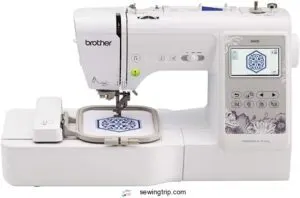
The Brother SE600 Sewing Embroidery Machine offers reliability and versatility. It handles various projects with ease, with 103 built-in stitches and 80 embroidery designs. Its 3.2" LCD color touchscreen simplifies navigation. The automated threader and drop-in bobbin ensure smooth operation.
Whether you’re a beginner or seasoned sewer, its quiet performance and bright LED light make it a joy to use. The SE600’s capability to sew knits and its custom design import enhance your creative freedom.
Best For: Experienced sewers and embroiderers seeking a versatile and durable machine for various projects.
- 103 built-in stitches and 80 embroidery designs for creative freedom
- Automatic threader and drop-in bobbin for ease of use
- Large color touchscreen and bright LED light for convenient operation
- Bulky and requires specific materials for embroidery
- May need to purchase a separate embroidery foot
- Manual must be read carefully to avoid problems
3. Juki TL2000Qi Sewing Quilting Machine
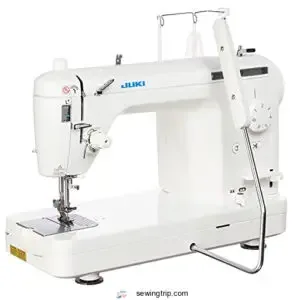
The Juki TL2000Qi is a quilting powerhouse. Boasting a 1500 SPM speed, it’s perfect for quilting, apparel, and home décor projects. Its die-cast aluminum construction guarantees low vibration, while the expansive harp area offers ample space for creative endeavors.
Designed for precision, it features an automatic needle threader and an extension table. Though it lacks some frills, its industrial quality and smooth, quiet operation make it ideal for serious quilters seeking flawless stitches without the fuss.
Best For: Serious quilters seeking flawless stitches without the fuss.
- Industrial quality construction
- 1500 SPM speed for fast, efficient quilting
- Automatic needle threader and extension table for added convenience
- No bells and whistles
- Does not include all feet and tension disks
- Requires a voltage converter for UK use
4. Brother HC1850 Sewing and Quilting Machine
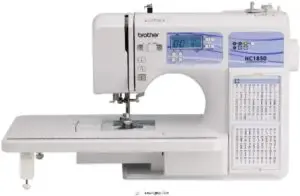
If versatility and performance are what you’re after, the Brother HC1850 is a top pick. With 185 built-in stitches, advanced needle threading, and a jam-resistant drop-in bobbin, you’re set for any quilting or embroidery project.
This lightweight and portable machine comes with a large backlit LCD display, making stitch selection intuitive. The wide table and spring action quilting foot provide ample space and functionality for larger projects.
Plus, you’ll get technical support for the life of the product.
Best For: Quilters and embroiderers seeking a versatile, high-performance machine.
- 185 built-in stitches for a wide range of projects
- Advanced needle threading for easy setup
- Jam-resistant drop-in bobbin for hassle-free sewing
- Not suitable for use in countries without 120V AC support
- Limited warranty coverage (25 years)
- Some users may find the machine’s weight (10.1 lbs) to be excessive
5. Janome Blue Couture Sewing Machine
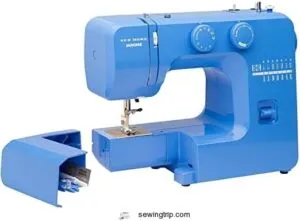
The Janome Blue Couture Sewing Machine offers precision and reliability for quilting and embroidery projects. With adjustable stitch length and zigzag width, a front-loading bobbin system, and a reverse lever, you’ll breeze through tasks. Its heavy-duty metal frame guarantees durability, while the removable free arm makes sewing sleeves and cuffs a breeze.
Dual retractable spool pins are handy for thread storage. Plus, tutorial videos and a built-in bobbin diagram make setup straightforward, guaranteeing you get started without a hitch.
Best For: Quilters and embroiderers seeking precision and reliability.
- Adjustable stitch length and zigzag width for customization
- Reverse lever for easy backstitching
- Removable free arm for sewing sleeves and cuffs
- Does not come with an invisible zipper foot
- May not be suitable for heavy-duty sewing or machine quilting
- Country of origin is China
6. JUKI MO600N Portable Thread Serger
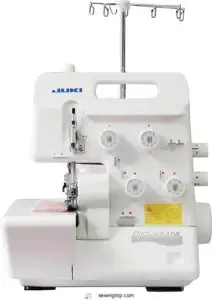
The JUKI MO600N Portable Thread Serger is a game-changer for quilting and embroidery enthusiasts. Its 2/3/4 thread options and a robust knife system handle a variety of fabrics with precision.
Achieve flawless finishes with its color-coded threading and automatic rolled hem. Despite its small size, this serger offers smooth, quiet operation and durability.
However, be mindful—it needs a stepdown converter for US use. Perfect for both beginners and pros seeking versatility in a compact form.
Best For: Quilting and embroidery enthusiasts seeking a versatile and portable thread serger.
- Color-coded threading and automatic rolled hem for flawless finishes
- Smooth, quiet operation and durability despite its compact size
- Handles a variety of fabrics with precision thanks to its 2/3/4 thread options and robust knife system
- Requires a stepdown converter for US use
- LED light can be too bright for some users
- Does not have a coverstitch
7. Janome HD1000 Black Edition Sewing Machine
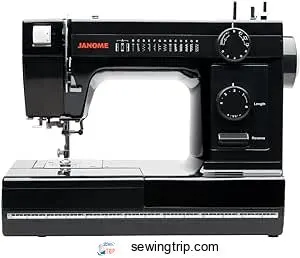
The Janome HD1000 Black Edition is truly a workhorse. With its industrial-grade aluminum frame and straightforward analog operation, you can tackle multiple layers with ease. It’s perfect for both quilting and embroidery.
Key features include a no-fuss threading system and sturdy construction, which means less maintenance and more sewing.
Beware of its fussiness with thread tail length and occasional bobbin winding challenges. Despite minor drawbacks, its durability and performance make it indispensable for any serious sewing enthusiast.
Best For: Serious sewing enthusiasts seeking a durable and powerful machine for quilting and embroidery.
- Industrial-grade construction for durability
- Easy-to-use analog operation for simple control
- Powerful motor for sewing through multiple layers
- Can be finicky about thread tail length
- Bobbin winding can be challenging
- May jam if not properly cleared of thread and fiber
8. Brother Sewing Quilting Machine
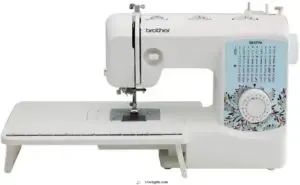
The Brother Sewing Quilting Machine stands out for its reliability and versatility. With 37 built-in stitches, it covers essentials like blind hem, decorative, and quilting stitches, plus a 1-step buttonhole feature.
The automatic needle threader and drop-in top bobbin simplify setup. Ideal for both beginners and advanced users, it includes a machine cover, wide table, and 8 sewing feet.
The versatile free arm enhances usability. Perfect for quilters and embroiderers seeking a dependable, feature-rich machine.
Best For: Beginners to advanced users seeking a reliable and versatile sewing machine.
- 37 built-in stitches, including blind hem, decorative, quilting, and 1-step buttonhole
- Automatic needle threader and drop-in top bobbin for easy setup
- Versatile free arm
- Intended for US only (120 volts)
- No information on stitch width or length
- No mention of warranty or customer support
9. Brother Computerized Sewing Machine
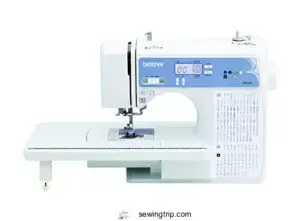
The Brother Computerized Sewing Machine is a versatile powerhouse that can handle all your sewing needs. With 165 built-in stitches, an automatic needle threader, and a drop-in top bobbin, this machine makes even complex projects a breeze.
The large LCD screen and wide table provide ample workspace, while the included accessories like the instructional DVD guarantee you’ll be sewing like a pro in no time.
Whether you’re a beginner or a seasoned sewist, this computerized machine will elevate your skills and bring your creative visions to life.
Best For: Experienced sewists looking for a versatile machine with advanced features.
- Extensive stitch selection (165 built-in stitches)
- Automatic needle threader and drop-in top bobbin for ease of use
- Large LCD screen and wide table for ample workspace
- Limited decorative stitches and small monogram font
- Pressure foot tension may be difficult to adjust for thicker materials
- Not recommended for beginners
Choosing the Right Machine for Quilting and Embroidery
Choosing the appropriate machine for quilting and embroidery involves contemplating whether you favor computerized or mechanical types, their dimensions, and their weight. You must also ponder the quantity and types of stitches, as well as the integrated accessories and features to ascertain that they comply with your project requirements.
Computerized Vs. Mechanical
Choosing between computerized and mechanical sewing machines depends on your specific needs. Computerized models, with their advanced features and precise functionality, excel in versatility and ease of use for intricate projects. Mechanical machines, known for their durability and simplicity, are perfect for straightforward stitching tasks. Both offer unique benefits, making the right choice essential for successful sewing and quilting.
Size and Weight
When selecting your machine, consider the size and weight for ideal quilting and embroidery. Verify it’s portable if you intend to relocate or store it frequently. Check for adequate workspace and a generous table size for quilting projects. Weigh the machine’s heft against your weight limitations to preserve comfort and command during use.
Number and Types of Stitches
Once you’ve considered size and weight, look at the number and types of stitches. Machines like the Brother CS7000X or Brother HC1850 offer extensive stitch variety. Check for adjustable stitch length and width, essential for quilting designs. Quality stitch patterns guarantee precision and durability, whether you’re using a Juki MO-654DE serger or a standard machine.
Accessories and Features
When choosing accessories and features for quilting and embroidery, prioritize accessories that guarantee seamless quilting and embroidery functions. Look for:
- Wide throat space: Essential for maneuvering large quilts.
- Specialized feet for quilting: Walking foot, free-motion foot, and quarter-inch foot.
- Stitch selection for embroidery: Variety and customization options.
- Troubleshooting quilting issues: Built-in guides or digital assistance.
Quality accessories guarantee seamless quilting and embroidery.
Essential Features for Quilting Machines
When selecting a quilting machine, focus on essential features like wide throat space for accommodating large projects, a dual-feed presser foot for even fabric feeding, and a knee lifter for hands-free operation. A stitch regulator is also vital for maintaining consistent stitch quality.
Wide Throat Space
When quilting, having an ample throat space is essential. Different throat widths, an adjustable throat size, or a wide extension table provide an oversized sewing space, necessary for handling large quilt sections. A quilting machine with sufficient work area like a longarm or tabletop quilting machine guarantees smooth, precise stitching on bulky projects. Enhance your crafting efficiency!
Dual-Feed Presser Foot
After ensuring ample throat space, you’ll want to focus on the dual-feed presser foot.
This nifty feature’s like having an extra set of hands, guiding both top and bottom fabric layers evenly. It’s a game-changer for quilting, preventing fabric slippage and ensuring perfect alignment.
Whether you’re working on intricate embroidery or tackling thick quilts, this presser foot technology’s got your back, making your sewing journey smoother than ever.
Knee Lifter
While dual-feed presser feet keep your fabric layers aligned, a knee lifter takes your quilting game to the next level.
This handy knee lever allows you to raise and lower the presser foot without taking your hands off your work. It’s a game-changer for precision piecing and intricate designs.
With a Juki or Janome machine equipped with a knee lifter, you’ll have unparalleled thread control and smoother changes between stitches.
Stitch Regulator
Just like a knee lifter, a stitch regulator is another game-changer for quilters. It guarantees your stitches stay consistent, whether you’re working on a Brother XR9550 or a Baby Lock Zest.
This nifty feature adjusts stitch length automatically, compensating for changes in your sewing speed. It’s especially handy for free-motion quilting, where maintaining even stitches can be tricky.
Factors to Consider When Buying a Sewing Machine
When choosing a sewing machine for quilting and embroidery, consider your intended use, budget, and the brand’s reputation for customer support. You’ll want to guarantee that the machine’s features align with your specific needs, whether that’s primarily quilting, embroidery, or garment sewing, while also factoring in your price range and the reliability of after-sales service.
Intended Use (quilting, Embroidery, Garment Sewing)
When choosing a sewing machine, consider your primary use:
- Quilting: Seek wide throat space, stitch regulator, and knee lifter.
- Embroidery: Prioritize machines with an embroidery foot, large hoop sizes, and multiple decorative stitches.
- Garment Sewing: Verify compatibility with varying fabric thickness, needle sizes, and bobbin types.
- Versatility: Machines with multiple functions and a high number of stitches.
Budget
When considering your budget for a sewing machine, remember that price often reflects features and capabilities. You’ll find budget-friendly options for beginners, as well as high-end machines with advanced quilting and embroidery functions.
Consider machines like the Brother SE600, which offer embroidery capabilities at a mid-range price point.
Don’t forget to factor in the cost of accessories, as they can greatly enhance your sewing experience.
Brand Reputation and Customer Support
When choosing a sewing machine, don’t overlook brand reputation and customer support. You’ll want a company that stands behind its products with solid warranty coverage and readily available repairs.
Look for brands like Janome and Baby Lock, known for their customer loyalty and technical support. Check if they offer online tutorials to help you master your machine.
Frequently Asked Questions (FAQs)
Can you quilt with a sewing and embroidery machine?
Yes, you can. In fact, 35% of quilters appreciate the versatility of a combination sewing and embroidery machine, allowing you to switch between precise quilting and intricate embroidery without skipping a beat.
What type of sewing machine do you need to quilt?
You’ll need a machine with a wide throat space, adjustable stitch length, and a walking foot. Look for features like a quilting table, free-motion capability, and automatic thread tension. Don’t forget a needle-down option for precise piecing.
What’s the difference between a quilting machine and sewing machine?
Did you know quilting machines can handle 1,800 stitches per minute? While sewing machines are versatile all-rounders, quilting machines excel at piecing large projects. They’ve got wider throats, stronger motors, and specialized features for handling thick layers.
What is the easiest quilting machine to use?
You’ll find the Baby Lock Zest ideal for quilting beginners. It’s user-friendly, with straightforward controls and a top-loading bobbin. The machine’s lightweight design and sturdy construction make it easy to maneuver while providing consistent stitches for your quilting projects.
What is the best sewing machine for embroidery & quilting?
You’ll love the Brother SE It’s a powerhouse for quilting and embroidery, offering 240 built-in stitches and 138 designs. With its large workspace and user-friendly interface, you’ll create stunning projects with ease and precision.
Which Brother Sewing Machine is best for quilting?
For quilting, you’ll love the Brother PQ1500SL. It’s a powerhouse with a wide table, knee lifter, and fast stitching speed. You’ll breeze through projects with its automatic thread cutter and adjustable presser foot pressure.
Can a sewing machine embroider and quilt?
Just as a Swiss Army knife tackles various tasks, many modern sewing machines can both quilt and embroider. You’ll find versatile models that switch seamlessly between functions, offering precision stitching for quilts and intricate designs for embroidery projects.
What sewing machine does not do computerized embroidery?
You’ll find many sewing machines that don’t offer computerized embroidery. Mechanical models like the Juki TL2010Q or Brother XR3774 focus on quilting and traditional sewing. They’re reliable workhorses that’ll tackle your projects without digital embroidery features.
Which sewing machine is best?
Picture yourself at the helm of a sewing powerhouse. You’ll find the best machine by balancing your needs and budget. Consider features like stitch variety, throat space, and user-friendliness. Don’t forget to test-drive before you buy!
Can a sewing machine make a quilt?
Yes, you can make a quilt with a sewing machine. You’ll need one with a wide throat space, walking foot, and free-motion quilting capability. Modern machines often come with built-in quilting stitches for added convenience.
How often should I service my quilting machine?
You should service your quilting machine annually or every 100 hours of use, whichever comes first. Regular maintenance keeps it running smoothly and prevents costly repairs. Don’t forget to oil it after each project for peak performance.
Can I use regular thread for embroidery projects?
Using regular thread for embroidery is like trying to paint a masterpiece with a crayon! For precision work, you need embroidery thread, which is designed for durability and sheen, ensuring your designs look professional and vibrant.
Whats the average lifespan of a high-end quilting machine?
You’ll typically get 15-20 years from a high-end quilting machine with proper care. Regular maintenance and timely repairs can extend its life even further. Durability varies by brand and usage, so invest wisely for long-term value.
Are there eco-friendly options for quilting and embroidery machines?
You’ll find eco-friendly sewing machines with energy-efficient motors and LED lights. Look for brands using recycled materials and offering carbon offset programs. Some manufacturers also produce machines with longer lifespans, reducing waste and environmental impact.
How do I properly store my machine between projects?
Holy sewing machine, Batman! To properly store your machine, cover it with a dust cover or pillowcase. Unplug and clean it thoroughly. Remove the needle and store accessories separately. Keep it in a cool, dry place away from direct sunlight.
Conclusion
Think of your sewing machine as a trusted companion on your creative journey.
Finding the best sewing machine for quilting and embroidery means carefully considering your needs and preferences. With the right model, like the versatile Brother SE600 or CS7000X, you’ll master both tasks.
Evaluate factors like size, weight, and essential features to make certain the machine fits your unique requirements.
Make an informed choice, and elevate your quilting and embroidery projects with confidence.

